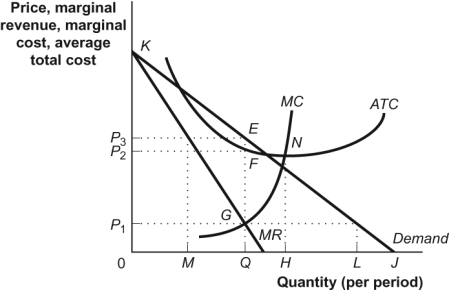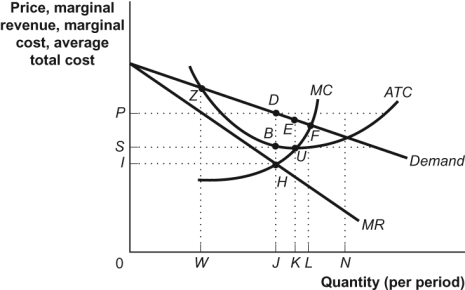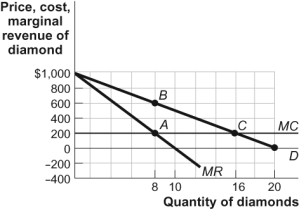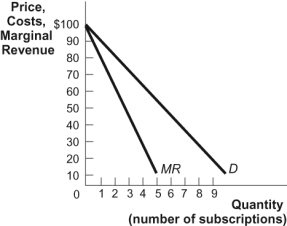A) a duopoly.
B) a monopoly.
C) an oligopoly.
D) perfect competition.
F) A) and D)
Correct Answer

verified
Correct Answer
verified
Multiple Choice
When a monopolist practices price discrimination,compared with a single-price monopolist,producer surplus will:
A) remain the same.
B) increase.
C) decrease.
D) increase initially and then return to its original level.
F) A) and C)
Correct Answer

verified
Correct Answer
verified
Multiple Choice
Price discrimination leads to a _____ price for consumers with a _____ demand.
A) higher;less elastic
B) higher;more elastic
C) higher;perfectly elastic
D) lower;less elastic
F) B) and C)
Correct Answer

verified
Correct Answer
verified
Multiple Choice
At a monopoly's profit-maximizing level of output:
A) marginal revenue equals marginal cost.
B) marginal revenue is greater than marginal cost.
C) marginal revenue is less than marginal cost.
D) price is less than marginal cost.
F) A) and C)
Correct Answer

verified
Correct Answer
verified
Multiple Choice
Suppose the elasticity of demand for tickets to see a play in the Toronto Theatre District shows is 2.0 for men and 0.3 for women.To use price discrimination to increase profits,the producers should charge lower prices to _____ because their demand is more _____.
A) men;elastic than that of women
B) men;inelastic than that of women
C) women;elastic than that of men
D) women;inelastic than that of men
F) A) and C)
Correct Answer

verified
Correct Answer
verified
True/False
When a monopolist practises price discrimination,consumer surplus will be higher than the consumer surplus in a single-price monopoly.
B) False
Correct Answer

verified
Correct Answer
verified
Multiple Choice
The demand curve for a monopoly is:
A) the MR curve above the AVC curve.
B) the MR curve above the horizontal axis.
C) the entire MR curve.
D) above the MR curve.
F) None of the above
Correct Answer

verified
Correct Answer
verified
Multiple Choice
Use the following to answer questions :
Figure: Computing Monopoly Profit  -(Figure: Computing Monopoly Profit) Use Figure: Computing Monopoly Profit.Producing at point N would:
-(Figure: Computing Monopoly Profit) Use Figure: Computing Monopoly Profit.Producing at point N would:
A) result in MR = MC.
B) result in positive economic profits.
C) never be profit-maximizing since,at this output,MR < 0 and MC > 0.
D) result in the firm breaking even.
F) A) and C)
Correct Answer

verified
Correct Answer
verified
Multiple Choice
A monopolist responds to a decrease in demand by _____ price and _____ output.
A) increasing;decreasing
B) increasing;increasing
C) decreasing;increasing
D) decreasing;decreasing
F) All of the above
Correct Answer

verified
Correct Answer
verified
Multiple Choice
Use the following to answer questions :
Figure: Monopoly Model  -If the government allowed only one airline to serve the entire U.S.market,there would be a _____ loss associated with _____ output in the airline industry.
-If the government allowed only one airline to serve the entire U.S.market,there would be a _____ loss associated with _____ output in the airline industry.
A) marginal;reduced
B) deadweight;reduced
C) total;increased
D) deadweight;increased
F) B) and C)
Correct Answer

verified
Correct Answer
verified
Multiple Choice
Which statement about the differences between monopoly and perfect competition is INCORRECT?
A) A monopolist has market power,while a perfect competitor does not.
B) Unlike a perfectly competitive firm,a monopoly can make positive economic profits in the long run.
C) A monopoly will charge a higher price and produce a smaller quantity than will a competitive market with the same demand and cost structure.
D) Monopoly profits can continue in the long run because the monopoly produces more and charges a higher price than does a comparable perfectly competitive industry.
F) None of the above
Correct Answer

verified
Correct Answer
verified
Multiple Choice
Use the following to answer questions :
Figure: The Profit-Maximizing Output and Price  -(Figure: The Profit-Maximizing Output and Price) Use Figure: The Profit-Maximizing Output and Price.Assume that there are no fixed costs and AC = MC = $200.At the profit-maximizing output and price for a monopolist,producer surplus is:
-(Figure: The Profit-Maximizing Output and Price) Use Figure: The Profit-Maximizing Output and Price.Assume that there are no fixed costs and AC = MC = $200.At the profit-maximizing output and price for a monopolist,producer surplus is:
A) $3 200.
B) $6 400.
C) $1 000.
D) $1 600.
F) B) and C)
Correct Answer

verified
Correct Answer
verified
Multiple Choice
Use the following to answer questions :
Figure: Monopoly Model  -In monopoly:
-In monopoly:
A) a basic condition for efficiency is violated because P > MC.
B) consumers are confronted with a price that is lower than marginal cost.
C) consumers will buy more of the good than is economically efficient.
D) consumers are confronted with a price that is lower than average total cost.
F) C) and D)
Correct Answer

verified
Correct Answer
verified
Multiple Choice
After the first unit sold,the marginal revenue a monopolist receives from selling one more unit of a good is less than the price of that unit because of:
A) diminishing marginal returns.
B) increasing marginal cost.
C) a downward sloping demand curve.
D) declining average fixed cost.
F) B) and D)
Correct Answer

verified
Correct Answer
verified
Multiple Choice
Use the following to answer questions : Scenario: Monopolist The demand curve for a monopolist is P = 75 -- 0.5Q,and the monopolist's marginal cost curve is defined using the equation MC = 2Q.Assume also that ATC at the profit-maximizing level of production is equal to $12.50. -(Scenario: Monopolist) Use Scenario: Monopolist.At the profit-maximizing level of output,the profit per unit is:
A) $62.50.
B) $0.00
C) $75.00.
D) $50.00.
F) A) and C)
Correct Answer

verified
Correct Answer
verified
Multiple Choice
Use the following to answer questions :
Figure: The Profit-Maximizing Output and Price  -(Figure: The Profit-Maximizing Output and Price) Use Figure: The Profit-Maximizing Output and Price.Assume that there are no fixed costs and AC = MC = $200.If this were a perfectly competitive industry,total surplus would be:
-(Figure: The Profit-Maximizing Output and Price) Use Figure: The Profit-Maximizing Output and Price.Assume that there are no fixed costs and AC = MC = $200.If this were a perfectly competitive industry,total surplus would be:
A) $6,400.
B) $1,600.
C) $3,200.
D) $4,800.
F) A) and D)
Correct Answer

verified
Correct Answer
verified
True/False
Usually when a monopoly that isn't a natural monopoly is broken up,the losses to the producer outweigh the gains to consumers.
B) False
Correct Answer

verified
Correct Answer
verified
Multiple Choice
Use the following to answer questions :
Figure: The Profit-Maximizing Output and Price  -(Figure: The Profit-Maximizing Output and Price) Use Figure: The Profit-Maximizing Output and Price.Assume that there are no fixed costs and AC = MC = $200.At the profit-maximizing output and price for a monopolist,total surplus is:
-(Figure: The Profit-Maximizing Output and Price) Use Figure: The Profit-Maximizing Output and Price.Assume that there are no fixed costs and AC = MC = $200.At the profit-maximizing output and price for a monopolist,total surplus is:
A) $3 200.
B) $4 800
C) $1 000.
D) $1 600.
F) A) and C)
Correct Answer

verified
Correct Answer
verified
Multiple Choice
Use the following to answer questions :
Figure: PPV  -(Figure: PPV) Use Figure: PPV.The figure shows the demand and marginal revenue for a pay-per-view football game on cable TV.Assume that the marginal cost and average cost are a constant $20.If the cable company is a monopoly,how much total surplus is there when the monopolist maximizes profit?
-(Figure: PPV) Use Figure: PPV.The figure shows the demand and marginal revenue for a pay-per-view football game on cable TV.Assume that the marginal cost and average cost are a constant $20.If the cable company is a monopoly,how much total surplus is there when the monopolist maximizes profit?
A) $240
B) $160
C) $100
D) $320
F) All of the above
Correct Answer

verified
Correct Answer
verified
Multiple Choice
Use the following to answer questions :
Figure: PPV  -(Figure: PPV) Use Figure: PPV.The figure shows the demand and marginal revenue for a pay-per-view football game on cable TV.Assume that the marginal cost and average cost are a constant $40.If the cable company practices perfect price discrimination,consumer surplus will be:
-(Figure: PPV) Use Figure: PPV.The figure shows the demand and marginal revenue for a pay-per-view football game on cable TV.Assume that the marginal cost and average cost are a constant $40.If the cable company practices perfect price discrimination,consumer surplus will be:
A) $180.
B) $100.
C) $40.
D) $0.
F) A) and B)
Correct Answer

verified
Correct Answer
verified
Showing 101 - 120 of 316
Related Exams